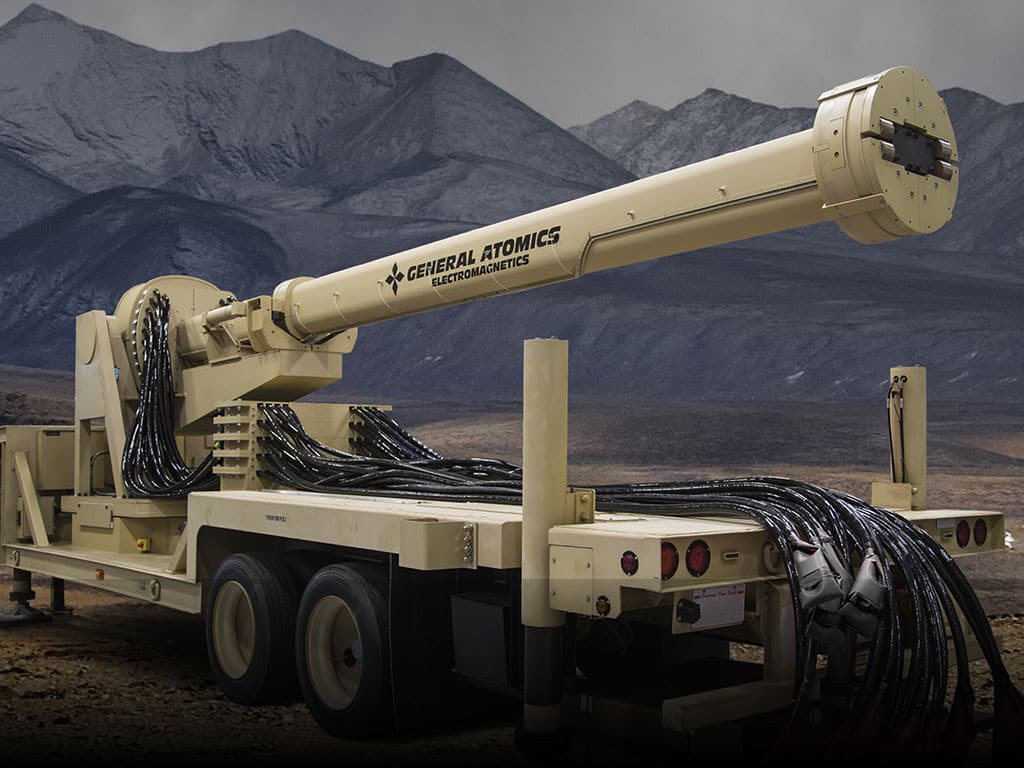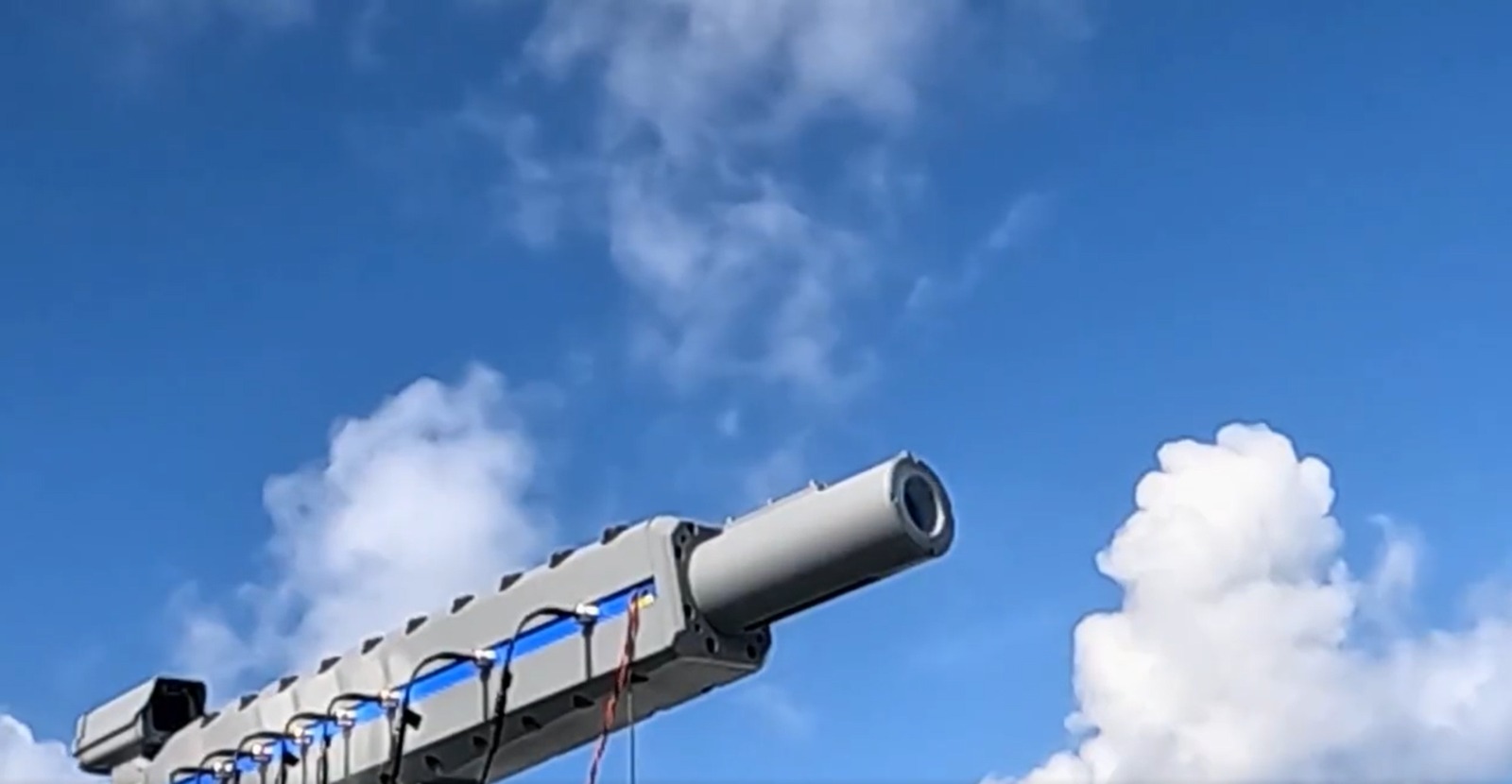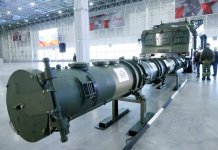Years after the US formally abandoned its electromagnetic railgun project, US-based defense contractor General Atomics has pitched a multi-mission railgun system that could be specifically tailored for air and missile defense applications, integrated into the aspirational Golden Dome initiative, and used to defend Guam.
A graphic of the railgun, developed by General Atomics Electromagnetic Systems (GA-EMS), was showcased by General Atomics at its booth at the Association of the United States Army’s annual convention in Washington, D.C., as reported by Naval News.
Railguns use electricity and magnetism to launch projectiles at hypersonic velocity. It typically consists of two parallel conductive rails connected to a power source, with an armature, or conductive projectile, between them. When a massive electric current is passed through the rails, it generates a magnetic field that exerts a force (the Lorentz Force) that slingshots the projectile forward at hypersonic speeds (Mach 5 or more).
In other words, instead of employing gunpowder and explosives, a railgun uses an electromagnetic field to push a metal ball toward its target at hypersonic speed. The projectile accumulates enough kinetic energy from its extraordinarily high speed to kill any potential target.
When asked about the system, Mike Rucker, Head of GA-EMS Weapons, said the company has submitted a railgun proposal for the Golden Dome initiative, launched by US President Donald Trump earlier this year.
The Golden Dome is a proposed multi-layer missile defense system designed to detect, track, and destroy various foreign threats, including ballistic, hypersonic, and cruise missiles, as well as potentially drones or other aerial threats during different phases of flight—boost (immediately after launch), midcourse (space travel), and terminal (re-entry).
Where a railgun-based air and missile defense system fits into this shield, whose design is still evolving, remains to be seen. However, GA-EMS believes it has the potential to provide a cost-effective solution for intercepting ballistic missiles, cruise missiles, and drones in the terminal phase.
According to an infographic, the GA-EMS’ multi-mission railgun system can fire projectiles at Mach 6. The graphic listed three variants of the railgun, with energy capacities ranging from three to thirty-two megajoules.

The company says these systems can intercept cruise and ballistic missiles. “Just the idea of the muzzle velocity and the standoff capability, and particularly from our perspective, from a terminal defense for air [and] missile defense. Just this with the tungsten pellets as the warhead,” Rucker was quoted as saying by Naval News.
In addition to the Golden Dome, Rucker pointed out that American forces protecting Guam would find the railgun’s terminal defense capabilities especially helpful.
Guam is a front-line US outpost in the Western Pacific that will potentially be used as a staging ground for US attacks on China in the event of a conflict. This island state, housing key US military facilities, is extremely vulnerable to Chinese long-range missile attacks. Therefore, the GA-EMS pitch essentially emphasises its potential to complement existing systems such as the Patriot or THAAD (Terminal High Altitude Area Defense).
Notably, GA-EMS has been the leading private developer of railgun technology in the United States since the early 2000s. After over 15 years of research and more than $500 million in investment, the US abandoned its railgun program in 2021 due to persisting technical hurdles. With competing priorities like hypersonic missiles, it was challenging to sustain financing for a high-risk technology given limited funds.
However, General Atomics continued to investigate and develop the experimental technology. In fact, Rucker went on to say that operational shortcomings of railgun technologies, including barrel wear and other technical difficulties, had since been resolved.
“The system works. It stopped because it wasn’t, you know, fieldable in an operational environment. The reliability aspects of it, right? But in terms of the technical challenges, the technical challenges have been solved. It’s pulling it all together and making it so soldiers and sailors can operate it,” he noted.
Further, he added that the company’s efforts garnered international attention, without naming any countries. He said that Washington was “cooperating” with them over their interest in the GA-ESM railgun products.
Interestingly, countries like China and Japan are currently advancing their railgun projects, whereas others in the West, including France, Germany, and Italy, are exploring their potential at this point.
The World Is Turning To Railgun Technology
In September 2025, Japan conducted its first test-firing of a ship-mounted railgun at a sea-based target—an effort that positioned the Asian country closer to becoming the first country to field railgun technology, far ahead of its closest ally, the United States.
The tests were conducted from June to early July using the prototype railgun mounted on the testbed JS Asuka ship, a 6,200-ton-displacement dedicated testbed with a warship-like design, as noted by Japan’s Acquisition Technology & Logistics Agency (ATLA).
“It’s the first time that a ship-mounted railgun was successfully fired at a real ship,” the ATLA said in a statement at the time.
The test was conducted using a medium-caliber, 8–9-ton, turret-mounted electromagnetic railgun prototype. The railgun prototype reportedly used 5 megajoules (MJ), or 5 million joules (J), of charge energy to fire at approximately Mach 6.5 in earlier testing. However, the specifics of the test were not disclosed.

According to the ATLA development roadmap, Japan aims to increase energy output to 20 MJ per shot. This increase would boost muzzle velocity and range, potentially exceeding Mach 7 and 150 kilometres, enable heavier projectiles or greater kinetic impact for anti-ship and anti-missile roles, and support sustained rapid-fire operations.
Currently, the research is focused on equipping the gun system with a suite of mechanisms for real-world operations. Additionally, efforts are underway to facilitate continuous firing, develop a dedicated fire control system, and enhance the projectile’s flight stability.
Tokyo is considering two major applications for the railgun, including interception of hypersonic missiles and a highly penetrative anti-ship capability with quick rates of fire.
China is another nation advancing the development of this sought-after technology. Its railgun program, which focuses on naval and ground-based applications to counter hypersonic threats, enhance anti-ship capabilities, and bolster missile defense in a contested environment, has consistently received funding and shown progress.
In 2018, China installed a railgun on the Type 072III-class landing ship Haiyangshan, which became the first at-sea prototype in history. Although the specifics were kept under wraps, it was tested with beginning velocities as high as Mach 7 and ranges of 100–200 kilometers.
According to reports, it tested a 124-kilogram projectile in 2023 with an initial velocity of 700 kilometers per hour. This was followed by another milestone, during which it conducted continuous firing with an AI-monitored system using 100,000 sensors to fire 120 rounds at Mach 6–7 without barrel damage.
By February 2024, Chinese naval researchers reportedly had overcome technical problems with hypersonic-speed ‘smart kinetic energy shells’ fired from an electromagnetic rail gun.
A team led by Feng Junhong at the National Key Laboratory of Electromagnetic Energy at the Naval University of Engineering conducted research that enabled the round to receive stable signals from the BeiDou satellite navigation system. It consistently adjusted its flight path, maintaining an error of less than 15 meters “until it hits its target.”
Many Western military analysts, however, viewed the Chinese statements with skepticism due to the lack of concrete evidence.
Besides Japan and China, France and Germany are currently collaborating on the development of this technology.
In May 2024, the defense ministries of Japan, France, and Germany (via ISL) signed the “Implementation Guidelines for Cooperation in Railgun Technology” and Terms of Reference (TOR). A few other countries, including Italy and Turkey, are also working on their respective railgun projects. However, no breakthrough has been forthcoming.

While the theory behind railgun technology is intriguing, there are still issues that have prevented any state from developing and deploying one, even after a century of research.
Typically, railguns require a great deal of electrical energy, which is provided by capacitors or pulsed power systems, as standard batteries can’t deliver the instantaneous power needed. This massive energy demand has been a hurdle, as a small railgun could consume the electrical power equivalent of 10,000 homes. It has proven extremely difficult to generate and store that much electricity.
Moreover, this system requires cooling, further limiting its use.
Another persistent issue engineers and scientists have faced over the years is barrel wear caused by excessive heat and friction. The parallel conductors were also often damaged by the strong electrical current and magnetic stress. The scientists needed to develop rails that could handle that much force consistently.
Several of these challenges persist, and the race to develop an electromagnetic railgun is far from over. The General Atomics proposal and assurances that old hurdles have been overcome are intriguing, but whether the US will revive its railgun program, abandoned four years ago, remains to be seen.
- Contact the author at sakshi.tiwari13 (at) outlook.com
- Follow EurAsian Times on Google News




